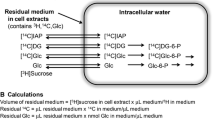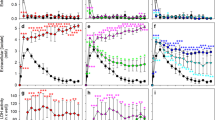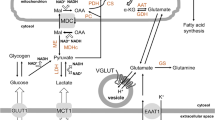Abstract
Glucose is a necessary source of energy for sustaining cell activities and homeostasis in the brain. Enhanced glucose uptake protects cells during energy depletion including brain ischemia. Astrocytes enhance their glucose uptake during ischemia to supply substrates to neurons and thus support neuronal survival. Radiolabeled substrates are commonly used for in vitro measurement of glucose uptake in astrocytes. Here we optimized a method to measure glucose uptake by astrocytes during oxygen-glucose deprivation (OGD) using the fluorescent substrate 2-(N-(7-nitrobenz-2-oxa-1,3-diazol-4-yl)amino)-2-deoxyglucose (2-NBDG). Uptake buffers for 2-NBDG were the same as for 14C-labeled α-methyl-d-glucopyranoside. Cell lysis buffer was optimized for observing the fluorescence of 2-NBDG, and Hoechst 33258 DNA staining was used for normalization of the 2-NBDG concentration. Uptake was performed on cultures of primary astrocytes by incubating the cells at 37 °C in buffer containing 25–200 μM 2-NBDG. Flow cytometry was performed to visualize uptake in intact cells, and a fluorescence microplate reader was used to measure the intracellular concentration of 2-NBDG in cell homogenates. 2-NBDG uptake was concentration dependent in astrocytes that were exposed or not exposed to OGD. OGD significantly increased 2-NBDG uptake by about 1.2 to 2.5 times in astrocytes compared to control cells. These results show that 2-NBDG can be used to detect glucose transport in astrocytes exposed to OGD.



Similar content being viewed by others
References
Barros LF, Bittner CX, Loaiza A, Ruminot I, Larenas V, Moldenhauer H, Oyarzun C, Alvarez M (2009) Kinetic validation of 6-NBDG as a probe for the glucose transporter GLUT1 in astrocytes. J Neurochem 109(Suppl 1):94–100
Blodgett AB, Kothinti RK, Kamyshko I, Petering DH, Kumar S, Tabatabai NM (2011) A fluorescence method for measurement of glucose transport in kidney cells. Diabetes Technol Ther 13(7):743–751
Blomstrand F, Giaume C (2006) Kinetics of endothelin-induced inhibition and glucose permeability of astrocyte gap junctions. J Neurosci Res 83(6):996–1003
Ciccarelli R, D’Alimonte I, Ballerini P, D'Auro M, Nargi E, Buccella S, Di Iorio P, Bruno V, Nicoletti F, Caciagli F (2007) Molecular signalling mediating the protective effect of A1 adenosine and mGlu3 metabotropic glutamate receptor activation against apoptosis by oxygen/glucose deprivation in cultured astrocytes. Mol Pharmacol 71(5):1369–1380
Denko NC (2008) Hypoxia, HIF1 and glucose metabolism in the solid tumour. Nat Rev Cancer 8(9):705–713
Dienel GA, Cruz NF, Adachi K, Sokoloff L, Holden JE (1997) Determination of local brain glucose level with [14C] methylglucose: effects of glucose supply and demand. Am J Physiol 273(5 Pt 1):E839–E849
Jakoby P, Schmidt E, Ruminot I, Gutierrez R, Barros LF, Deitmer JW (2013) Higher Transport and Metabolism of Glucose in Astrocytes Compared with Neurons: A Multiphoton Study of Hippocampal and Cerebellar Tissue Slices. Cortex, Cereb
Kim WH, Lee J, Jung DW, Williams DR (2012) Visualizing sweetness: increasingly diverse applications for fluorescent-tagged glucose bioprobes and their recent structural modifications. Sensors (Basel) 12(4):5005–5027
Pellerin L, Magistretti PJ (2004) Neuroenergetics: calling upon astrocytes to satisfy hungry neurons. Neuroscientist 10(1):53–62
Rossi DJ, Brady JD, Mohr C (2007) Astrocyte metabolism and signaling during brain ischemia. Nat Neurosci 10(11):1377–1386
Shen LH, Li Y, Gao Q, Savant-Bhonsale S, Chopp M (2008) Down-regulation of neurocan expression in reactive astrocytes promotes axonal regeneration and facilitates the neurorestorative effects of bone marrow stromal cells in the ischemic rat brain. Glia 56(16):1747–1754
Takano T, Oberheim N, Cotrina ML, Nedergaard M (2009) Astrocytes and ischemic injury. Stroke 40(3 Suppl):S8–S12
Vannucci SJ, Maher F, Simpson IA (1997) Glucose transporter proteins in brain: delivery of glucose to neurons and glia. Glia 21(1):2–21
Vannucci SJ, Reinhart R, Maher F, Bondy CA, Lee WH, Vannucci RC, Simpson IA (1998) Alterations in GLUT1 and GLUT3 glucose transporter gene expression following unilateral hypoxia-ischemia in the immature rat brain. Brain Res Dev Brain Res 107(2):255–264
Yamada K, Nakata M, Horimoto N, Saito M, Matsuoka H, Inagaki N (2000) Measurement of glucose uptake and intracellular calcium concentration in single, living pancreatic beta-cells. J Biol Chem 275(29):22278–22283
Yoshioka K, Saito M, Oh KB, Nemoto Y, Matsuoka H, Natsume M, Abe H (1996) Intracellular fate of 2-NBDG, a fluorescent probe for glucose uptake activity, in Escherichia coli cells. Biosci Biotechnol Biochem 60(11):1899–1901
Yu JT, Tan L, Ou JR, Zhu JX, Liu K, Song JH, Sun YP (2008) Polymorphisms at the beta2-adrenergic receptor gene influence Alzheimer’s disease susceptibility. Brain Res 1210:216–222
Zou C, Wang Y, Shen Z (2005) 2-NBDG as a fluorescent indicator for direct glucose uptake measurement. J Biochem Biophys Methods 64(3):207–215
Acknowledgements
This work was supported by the National Nature Scientific Foundation of China (no. 81171029).
Author information
Authors and Affiliations
Corresponding author
Rights and permissions
About this article
Cite this article
Chen, Y., Zhang, J. & Zhang, Xy. 2-NBDG as a Marker for Detecting Glucose Uptake in Reactive Astrocytes Exposed to Oxygen-Glucose Deprivation In Vitro. J Mol Neurosci 55, 126–130 (2015). https://doi.org/10.1007/s12031-014-0385-5
Received:
Accepted:
Published:
Issue Date:
DOI: https://doi.org/10.1007/s12031-014-0385-5




